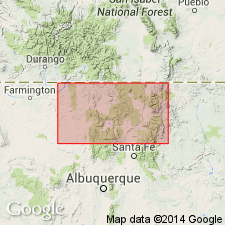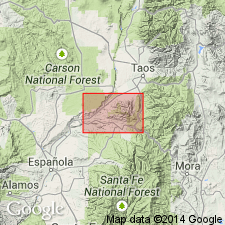
- Usage in publication:
-
- Dixon granite
- Modifications:
-
- Named
- Dominant lithology:
-
- Granite
- AAPG geologic province:
-
- Southern Rocky Mountain region
Summary:
Named. Neither source of name (town of Dixon?) nor type locality designated. Is a coarse-grained, even-grained, pink and gray biotite granite. Varies in texture and composition. Has a porphyritic phase that is intruded by aplite dikes. In places granite has been changed to schist. Dimensions unknown; may be batholithic in size. Occurs in hills west and south of Harding mine, along the Rio Pueblo from Dixon to Picuris, and in isolated outcrops from Las Trampas to Penasco, T23N, Rs12 and 13E, Taos Co, NM and Ts22 and 23N, R10E, Rio Arriba and Taos Cos, NM in Southern Rocky Mountain region. Intrudes Proterozoic sedimentary rocks. Assigned a Proterozoic age. Is contemporaneous with Tusas granite (named). Geologic map.
Source: GNU records (USGS DDS-6; Denver GNULEX).

- Usage in publication:
-
- Dixon granite
- Modifications:
-
- Not used
Summary:
Embudo granite (new, this report) replaces name Dixon granite of Just (1937), which is preempted, and therefore not used.
Source: GNU records (USGS DDS-6; Denver GNULEX).
For more information, please contact Nancy Stamm, Geologic Names Committee Secretary.
Asterisk (*) indicates published by U.S. Geological Survey authors.
"No current usage" (†) implies that a name has been abandoned or has fallen into disuse. Former usage and, if known, replacement name given in parentheses ( ).
Slash (/) indicates name conflicts with nomenclatural guidelines (CSN, 1933; ACSN, 1961, 1970; NACSN, 1983, 2005, 2021). May be explained within brackets ([ ]).

